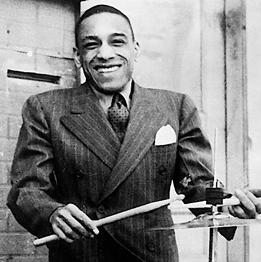Introduction:
In the vibrant tapestry of jazz history, certain figures stand out not only for their musical prowess but also for their transformative impact on the genre. Chick Webb, a virtuoso drummer and bandleader, occupies a significant place in the pantheon of jazz legends. His indomitable spirit and groundbreaking contributions to the Swing Era make him a compelling subject of exploration.
Early Life and Struggles:
Chick Webb, born William Henry Webb one hundred and nineteen years ago today on February 10, 1905, in Baltimore, Maryland, faced the challenges of life with fortitude from an early age. Afflicted with spinal tuberculosis, he developed a hunchback, but this physical adversity did not deter his passion for music. Webb’s fascination with drumming became evident as he first played professionally at age 11, exhibiting an innate talent that would later propel him to jazz stardom.
Help yourself to some live jazz, and help the artists and clubs fulfill their dreams. Sign up to Oh! Jazz to watch live and on-demand performances. 25% of your subscription goes back to the artists and 10% to the clubs.
Learn more about Oh! Jazz here.
The Rise of the Savoy King:
Webb’s ascent in the jazz scene was meteoric. In the 1920s, he began establishing his reputation as an exceptional drummer, drawing attention for his technical prowess and unmatched energy behind the drum kit. By 1926, Webb had formed his own band, which became the Chick Webb Orchestra in 1931, and which would soon become synonymous with the vibrant swing sound of the era.
The pinnacle of Webb’s career was undoubtedly his residency at the Savoy Ballroom in Harlem, New York. The Savoy was not just a venue; it was a crucible of innovation. Webb’s orchestra, with its infectious rhythms and dynamic arrangements, provided the perfect sonic backdrop for the exuberant dancers at the Savoy. The band’s regular battles with other jazz giants of the time, such as Count Basie and Benny Goodman, became legendary, solidifying Webb’s moniker as the “Savoy King.”
The Ella Fitzgerald Collaboration:
A transformative juncture in Webb’s illustrious career unfolded during his collaboration with a then-young and relatively obscure vocalist, Ella Fitzgerald. In 1935, faced with the need for a female vocalist in his band, Webb turned to Charles Linton, the lead singer of his ensemble. Hearing of Ella’s triumph in an amateur competition at the Apollo Theater, Linton sought her out and was captivated by her singing prowess. Convinced of Ella’s exceptional talent, he brought her to Webb, who, initially skeptical, hesitated to embrace this untested artist. Linton, committed to Ella’s potential, issued an ultimatum, threatening to resign if Webb did not give her an audition. Yielding to Linton’s insistence, Webb granted Ella a two-week trial, during which her vocal artistry surpassed all expectations. Recognizing her unparalleled talent, Webb appointed Ella Fitzgerald as his lead female vocalist, marking the commencement of a legendary musical partnership.
Over time, Webb became not just a bandleader but also a mentor to Fitzgerald, nurturing her talent and shaping her into the iconic jazz vocalist she would later become. Their recordings, including hits like “A-Tisket, A-Tasket,” showcased a magical synergy between Webb’s pulsating rhythms and Fitzgerald’s enchanting vocals.
Legacy and Influence:
Tragically, Chick Webb’s life was cut short. His health, always fragile due to his spinal condition, deteriorated rapidly. He succumbed to complications from tuberculosis on June 16, 1939, at the young age of 34. Despite his premature death, Webb’s impact on jazz was enduring.
Webb’s influence extended beyond his drumming virtuosity. His role in breaking racial barriers in the music industry was groundbreaking. As an African American bandleader in a racially segregated era, Webb defied norms and paved the way for future generations of Black musicians.
The Chick Webb Orchestra continued for a brief period after his death under the leadership of Ella Fitzgerald. However, it eventually disbanded, marking the end of an era.
Chick Webb’s legacy is that of a drumming dynamo who, despite physical challenges, left an indelible mark on the world of jazz. His role in shaping the Swing Era and his mentorship of Ella Fitzgerald are testaments to his musical genius and resilience. As we revisit the energetic rhythms of the Swing Era, let’s not forget the Rhythm King, Chick Webb, whose beats echoed through the hallowed halls of the Savoy Ballroom, forever imprinting his name in the annals of jazz history.
References:
- Schuller, G. (1991). The Swing Era: The Development of Jazz, 1930-1945. Oxford University Press.
- Chick Webb picture. Retrieved from https://en.wikipedia.org/wiki/File:Chick_Webb.jpg

Leave a Reply